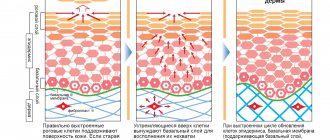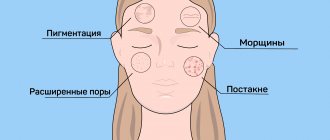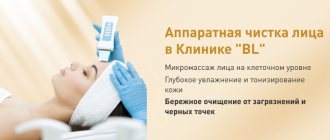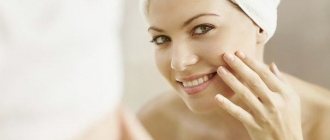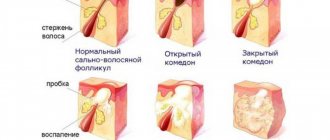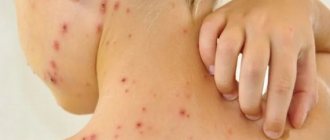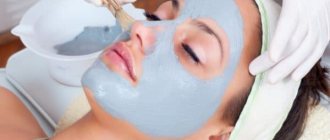Peeling stimulates the renewal of the epidermis, eliminates minor surface defects, gives the face radiance and visibly rejuvenates it.
Let's look at how chemical peels work, who is recommended for such procedures, and what results you should expect.
The name of the procedure comes from the English verb “to peel” - to exfoliate, cleanse, remove the crust. The cosmetic name of the procedure is exfoliation (exfoliation, cleansing). With the help of peeling, the top layer of the epidermis is removed - dead cells that spoil the complexion, give the skin an unhealthy appearance and make it difficult to breathe.
This can be done in different ways: mechanically (using a scrub), using a laser or special compositions that stimulate cell exfoliation. The last option is called chemical peeling.
What it is?
Healthy skin is constantly renewed, and the upper - horny - layer of the epidermis consists of dead cells. They gradually peel off, giving way to new ones. If this process slows down, the layer of dead cells becomes too thick. As a result, the breathing of the skin is disrupted, its surface becomes uneven, the complexion deteriorates, and other defects appear.
They contain acids that dissolve dead cells and stimulate the process of exfoliation of the upper layer of the epidermis. More concentrated formulations affect both the middle and deep layers of the skin.
At its core, the procedure is a controlled damage (chemical burn) to the skin. The body reacts to such exposure with intensive restoration and cell renewal: damaged layers are replaced with new ones. As a result, the face looks much younger and fresher.
The history of chemical peelings began in ancient times, when beauties used wine, fruit juices and fermented milk products to prolong their youth. The development of chemistry in the late 19th and early 20th centuries gave women effective but unsafe peelings using concentrated acids and toxic substances. They were popular with the most desperate ladies who wanted to preserve their beauty for many years at any cost. Only later, at the end of the 20th century, when scientists studied the properties of alpha hydroxy acids (AHA), modern superficial and medium peels appeared - delicate but effective. Such procedures quickly gained popularity, and now cosmetology clinics offer a wide variety of options to suit every taste.
Varieties
Depending on which layers are affected by chemical compounds, there are three types of peelings:
- Surface. The most gentle procedure that can be carried out even at home (in this case, the most gentle preparations with a minimum content of active ingredients are used). The area of influence is limited to the epidermis (stratum corneum), living cells are not affected. The acid concentration is low (up to 20%), the treatment process is painless, and recovery does not take much time. The effect accumulates, so superficial peelings are carried out in courses that consist of 5-10 sessions. By the end of the course the effect reaches its maximum. The procedure evens out and improves complexion, giving the skin velvety, fresh, smooth and tender. Superficial peelings are often used as part of complex procedures, as they improve the penetration of beneficial substances from masks, serums, and creams into the dermis;
- Median. In this case, more concentrated (30-40%) drugs are used, which act not only on the epidermis, but also on the dermis (papillary layer). Intense exposure allows you to achieve a noticeable rejuvenation effect, eliminate post-acne and wrinkles. However, this option is more damaging to the skin than the previous one. For this reason, it is not recommended for everyone; moreover, medium peeling can only be entrusted to a professional cosmetologist in the clinic. An example of a medium peel is the TSA peel with trichloroacetic acid. Such peels are now used extremely rarely due to the large number of side effects;
- Deep. The impact extends to all layers of the skin, including the basal layer. To treat the skin, phenol is used, a toxic substance, which is supplemented with compounds that prevent the rapid absorption of the drug. This is a very aggressive and traumatic procedure related to surgical manipulations; it is necessarily carried out using anesthesia and only in a hospital. Deep effects can significantly rejuvenate the face and get rid of such serious defects as scars, but it is recommended to do it only in adulthood (over 60 years old) and no more than once in a lifetime. The recovery period after such manipulation can take six months.
The higher the concentration of acids, the stronger the burn, the more the skin is injured, and the more actively it is restored.
Peels for home use should not be overestimated: the acid content in them is minimal, and the effect cannot be compared with the results of procedures performed in the clinic. When creating cosmetics, manufacturers rely on safety, so that even if used incorrectly, you cannot harm yourself.
Professional products are a completely different matter. They are designed for specialists who strictly follow protocols and strictly follow all recommendations. That is why even a course of superficial peelings in the clinic provides a noticeable rejuvenation effect (detailed study of the usefulness of chemical peels).
The effectiveness of peelings depends on the concentration of active substances, pH (the higher it is, the less damage to the skin), application technique and number of layers, exposure time and the previous preparation procedure.
Care after ultrasonic facial cleansing
Another painless and atraumatic technique. Sebum and impurities are removed from the pores using high frequency ultrasonic waves. The skin receives an additional massage and an incentive for self-rejuvenation - small wrinkles are smoothed out, and collagen and elastin are synthesized more actively. The only negative is that due to the shallow impact, the procedure is ineffective for skin with serious problems.
Skin care after ultrasonic facial cleansing boils down to using cleansers with a neutral pH, additional cleansing with alcohol-free gels and lotions, and moisturizing with face masks.
Indications
Superficial peelings allow you to solve the following problems:
- Improving the quality of the skin;
- Leveling the surface of the epidermis;
- Elimination of pigmentation;
- Improved complexion;
- Narrowing of pores;
- Improving turgor, elasticity;
- Reducing the manifestations of post-acne;
- Preparation for cosmetic and surgical interventions.
Medium varieties have a more intense effect and can also combat:
- Wrinkles;
- Pronounced pigmentation;
- Post-acne;
- Flabbiness;
- Stretch marks;
- Scars;
- Hyperkeratosis.
Deep peels are indicated for patients over 60 years of age with pronounced age-related changes, scars, cicatrices and pigmentation.
In most cases, it is recommended to start with a course of superficial peeling, which is useful not only in itself, but also as a preparation for more intense effects.
Peeling is a universal procedure that is suitable for patients of all ages. If in adulthood it is recommended for renewal and rejuvenation of the skin, then for young girls peelings help cope with post-acne, enlarged pores and other defects. Regular exfoliation of the surface layer of the epidermis is also useful for acne, but in this case it is recommended to combine peeling with other procedures, for example, ultrasonic cleansing and mesotherapy.
Contraindications
- Inflammation, rashes (including allergic ones), violations of the integrity of the skin in the treatment area;
- Any acute (exacerbated chronic) diseases, febrile conditions;
- Exacerbation of herpes;
- Hypertension;
- Oncological diseases;
- Aggressive influences on the treated area less than two months before peeling;
- Taking certain medications, incl. increasing photosensitivity;
- Pregnancy and lactation;
- Psoriasis, rosacea, telangiectasia (only the most delicate peels are indicated);
- Large birthmarks in the treatment area;
- Fresh tan;
- Individual intolerance to components.
The list of contraindications may vary depending on the type and concentration of the active substance.
The procedure for rosacea is prescribed with caution. It is not recommended to carry out the course in spring and summer for those who spend a lot of time in the sun.
Advantages of this procedure
Acid peeling has many advantages:
- effective at any age, provided the correct composition is selected;
- stimulates cell renewal, promotes rejuvenation;
- activates tissue regeneration;
- helps reduce the depth of scars and cicatrices;
- effective in the treatment of acne, acne, comedones;
- restores the structure and oval of the face;
- removes hyperpigmentation, freckles, age spots;
- normalizes a healthy complexion;
- promotes collagen production, thereby increasing skin elasticity and firmness;
- inhibits fading processes;
- reduces the depth of wrinkles, fights sagging;
- reduces pores, normalizes sebum production;
- controls water balance;
- provides full access of oxygen and nutrients to cells;
- stimulates blood circulation and microcirculation;
- restores velvety and smoothness of the skin.
Chemical exfoliation is one of the effective ways to rejuvenate and heal the skin. The technique provides the fastest possible results; it is an excellent alternative to surgical interventions and plastic surgery.
How is peeling performed?
Acid peeling is a seasonal procedure that is recommended during the cold season. This is due not so much to the air temperature, but to the fact that in autumn and winter the sun is much less active than in summer, which means the risk of pigmentation is reduced.
The procedure consists of several stages:
- Cleansing. The doctor removes remaining cosmetics and impurities using neutral products. After this, the surface of the epidermis is thoroughly dried;
- Application of the drug. Peels can be in the form of aqueous solutions, gels, thick creams. The denser the consistency, the more delicate the effect. In any case, the product is applied first to denser, and only then to more delicate areas of the skin;
- Removing a tool. Depending on the type of peeling, the drug remains on the face from 1 to 15 minutes. After this, you can proceed to the next stage. There are also peelings, for example yellow peeling, with which the patient goes home and washes off on his own after a few hours;
- Neutralization. A preparation is applied to the treated areas, which tones, refreshes and soothes the epidermis, moisturizes it and neutralizes the effects of acids. The neutralizer should also be left on the face for a few minutes and then washed off with water. If you skip this step, burns may occur;
- Hydration. After removing the neutralizer, a moisturizing cream, gel, serum or mask with a soothing effect is applied to the face. At this time, the skin is especially receptive, so the effect of cosmetics is extremely effective.
Before leaving the clinic, you must protect your epidermis with SPF cream.
Facial care after mechanical cleansing
The method effectively solves the problem of acne and comedones, but is also the most traumatic. The cosmetologist manually cleans problem areas, after steaming and thoroughly cleansing the skin. The procedure is completed with a soothing mask.
The main disadvantages of the procedure are the risk of inflammation and scarring. Therefore, facial skin care after mechanical cleansing should be especially thorough. Recovery takes up to 5-7 days. During this period, you should regularly degrease the skin with antiseptic preparations that do not contain alcohol. Soothing compresses will help reduce swelling.
What compounds are used
Preparations for peeling are selected individually depending on the characteristics of the skin and its condition. The higher the acid concentration, the more effective the effect, and the less suitable this option is for delicate, sensitive skin. Different types of acids also differ greatly from each other. Depending on the size of the molecules and the depth of penetration, they can act more or less delicately, which means they are suitable for different skin types.
The most popular types of chemical peels:
- Almond. This is a superficial peeling based on mandelic acid, which has an exfoliating, moisturizing, and antiseptic effect. Due to its large size, the mandelic acid molecule penetrates shallowly into the skin and acts very gently. Almond peels do not increase photosensitivity and can be used all year round. Finally, it is an optimal choice for problematic, impure skin, as mandelic acid prevents the formation of comedones and clears out crusts. The course consists of 6-10 procedures;
- Pyruvic (summer). Another gentle option for year-round use. This superficial peeling uses pyruvic and lactic acids, which stimulate cell regeneration, moisturize the epidermis and tighten pores. The procedure is suitable for dry and sensitive skin;
- Yellow. Retinoic acid, which can be used for both superficial and mid-level peels, has a rich yellow tint, which gives the procedure its name. It must be borne in mind that after such exposure the epidermis also acquires a yellowish tint for some time. The acid penetrates deeply into the dermis and triggers regeneration processes. This is a good choice at the first signs of aging, since the procedure has a pronounced rejuvenating effect, and also tightens the skin, gives it elasticity, and regulates the functioning of the sebaceous glands. Like other medium peels, it requires special preparation;
- Biophytopilling. This is a superficial peeling based on hydroxyl acids, supplemented with plant extracts and vitamins. The procedure instantly improves the condition of the skin and complexion, gives the epidermis elasticity and smoothness. Biophytopilling is carried out in courses and is suitable for any skin except very dry skin;
- Melaspil. The drug contains salicylic and hydroxypropionic acids, as well as resorcinol and depigmenting agents. Medium peeling is optimal for combating hyperpigmentation; it perfectly whitens, rejuvenates the skin and improves its condition. Not suitable for dark skinned people;
- PRX-T33. This product is specially designed for sensitive and dry skin. After the procedure, there is no peeling of the skin, but the dermis is intensively renewed under the influence of trichloroacetic acid TCA, kojic acid and peroxide;
- Trichloroacetic. This option is famous for the fact that it effectively tightens enlarged pores, improves complexion, and eliminates signs of photo- and chronoaging;
- Jessner peeling. Mid-surface version based on salicylic and lactic acids with resorcinol. Recommended for oily or aging skin. Depending on the number of layers applied to the face, it is used as a surface or middle layer;
- Salipil (anti-acne). A drug based on salicylic acid is used, has a pronounced anti-inflammatory effect and helps fight rashes. Also suitable for mature skin;
- Depigmenting. As the name suggests, this variety is designed to combat hyperpigmentation. For such peels, various acids can be used alone or in different combinations. Whitens and rejuvenates, gives freshness and matteness;
- Fruit. In this case, fruit acids are used. Depending on the concentration, they have a gentle or more intense effect on the epidermis. Suitable for any age, especially effective at the first signs of aging. A good choice for problematic, rash-prone skin;
- Glycolic. The acid contained in green grapes and sugar cane is used. Due to its low molecular weight, it penetrates well into the skin and has an effective effect. Suitable for refreshing all skin types, smoothes out fine wrinkles, tightens pores and eliminates pigmentation well;
- Lactic. In this case, the acid contained in fermented milk products, as well as blueberries, tomato juice, grapes, and apples is used. It has a pronounced exfoliating and moisturizing effect.
The cosmetologist selects the appropriate option depending on the condition of the epidermis and existing defects.
Care after laser facial cleansing
A laser beam of a given frequency penetrates deep into the dermis, completely removing the upper problematic layer along with comedones, acne and age spots. The procedure has a rejuvenating effect. Recovery takes 3-5 days. During this time, you should limit your exposure to the sun, avoid temperature changes and intensively moisturize your skin.
Care after combined facial cleansing involves following the principles prescribed for each procedure. Until complete recovery, you should avoid decorative cosmetics, do not use products with alcohol, and protect your skin from ultraviolet radiation and physical influences.
Rehabilitation
After chemical peels, you need to take good care of your skin to give it a chance to recover. First of all, hydration is necessary. It is recommended to use products with hyaluronic acid, panthenol, aloe and vitamins. In addition, you should avoid any aggressive procedures, the use of alcohol-containing cosmetics, retinoids, and mechanical scrubs. When crusts appear, you cannot remove them yourself - you should be patient and wait until they fall off spontaneously.
It is extremely important to protect your face from ultraviolet radiation. The renewed epidermis is especially sensitive to such effects, so the risk of age spots increases. So the use of protective lotions with a high SPF factor is mandatory not only in the summer (when peeling is generally not recommended), but also in the winter.
To maintain the effect, your doctor may recommend using special cosmetics containing acids. They can be included in creams for everyday use in low concentrations sufficient to preserve the results for a long time.
After superficial treatment, the skin is restored quickly, however, during the entire course and two weeks after its completion, careful care and avoidance of any aggressive influence are necessary.
Fabrics that pill the most
The degree of pillability is influenced by the composition of the fiber, the structure of the threads, the degree of twist of the thread, the density of the fabric, the structure of the fabric, its finishing and processing.
The higher quality and purer the fiber, the lower the pillability and, conversely, the more waste was used in its production, the higher the pillability.
Pilli (pellets) are formed on:
- Low-density fabrics,
- Fabrics with low twist,
- Knitted fabrics,
- Materials with fine fibers,
- Synthetic products,
- Mixed materials.
The above-mentioned fabrics with greater pillability include:
Synthetic:
- Polyester;
- Elastane (spandex, lycra, dorlastan, lionel);
- Polyamide (nylon).
Acrylic is the lowest pilling synthetic fabric.
Mixed fabrics, where there is an approximately equal ratio of natural and synthetic fibers, are subject to a high degree of pilling:
- Polycotton;
- Knitwear.
Effect
After a course of procedures, the face becomes fresh and youthful. Peels are very popular precisely because the results are clearly visible. It can be appreciated not only by attentive observers - even casual acquaintances will notice a clear improvement in the condition of the skin.
Compliments are guaranteed after the first sessions, and by the end of the course:
- Improves and evens out complexion;
- Wrinkles are smoothed out and disappear;
- Elasticity and turgor increase;
- Pigmentation disappears;
- The skin becomes smooth and soft;
- Acne goes away;
- Scars are smoothed out, incl. from post-acne;
- Pores tighten;
- The functioning of the sebaceous glands is normalized.
Peeling courses combine well with other cosmetic procedures - both hardware and injection. A cosmetologist will tell you how best to combine different types of treatment to achieve optimal results.
Low pilling fabrics
There are a certain number of materials that are not subject to a process called pilling. These include natural fabrics: cotton, linen, wool, silk and some artificial ones. Let's look at them in more detail next.
Cotton fabrics
Cotton fabrics with low pilling properties include:
- Chintz;
- Denim;
- Batiste;
- Calico;
- Poplin;
- Veil;
- Kanifas:
- Percale;
- Teak;
- Pique.
